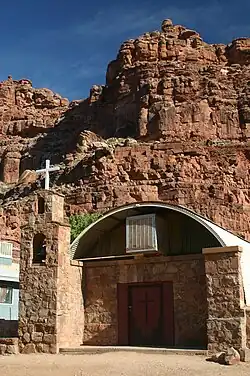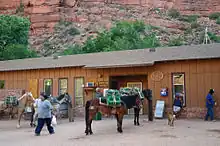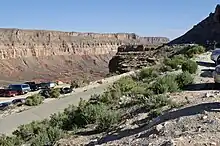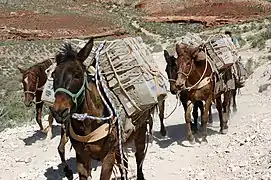Supai, Arizona
Supai (Havasupai: Havasuuw) is a census-designated place (CDP) in Coconino County, Arizona, United States, within the Grand Canyon.
Supai, Arizona | |
|---|---|
 Church building in Supai | |
 Location in Coconino County and the state of Arizona | |
 Supai Location in Arizona  Supai Location in the United States | |
| Coordinates: 36°13′27″N 112°41′38″W | |
| Country | |
| State | |
| County | Coconino |
| Area | |
| • Total | 1.72 sq mi (4.46 km2) |
| • Land | 1.72 sq mi (4.46 km2) |
| • Water | 0.00 sq mi (0.00 km2) |
| Elevation | 3,195 ft (974 m) |
| Population (2010) | |
| • Total | 208 |
| • Density | 120.9302/sq mi (46.6367/km2) |
| Time zone | UTC-7 (MST) |
| ZIP code | 86435 |
| Area code | 928 |
| FIPS code | 04-71230 |
| GNIS feature ID | 12003 |
| Website | theofficialhavasupaitribe |
As of the 2010 census, the CDP had a population of 208.[2] The capital of the Havasupai Indian Reservation, Supai is the only place in the United States where mail is still carried in and out by mules.[3]
Supai has been referred to as "the most remote community" in the contiguous United States by the U.S. Department of Agriculture.[4] It is accessible only by helicopter, on foot or by mule. Supai is 8 miles (13 km) from the nearest road and has no automobiles in the community.[3]
History
In 1910 there was a flood of Supai which affected the town.[5]
In the 1960s Martin Goodfriend, a tourist, began to advocate for the Supai people, and a columnist of the Arizona Republic, Don Dedera, wrote articles about Goodfriend's findings.[6] Dedera stated that Goodfriend countered a view that Supai was a kind of "Shangri-la".[7]
Tourists and some residents were evacuated from Supai and surrounding area on August 17 and 18, 2008,[8] due to flooding of Havasu Creek complicated by the failure of the earthen Redlands Dam (subsequent to the main flooding event[9][10]) after a night of heavy rainfall. Evacuees were taken to Peach Springs, Arizona.[11] More heavy rains were expected and a flash flood warning was put into effect, necessitating the evacuation, according to the National Park Service.[12] The floods were significant enough to attract coverage from international media.[11][13]
Damage to the trails, bridges, and campground was severe enough for Havasupai to close visitor access to the village, campground, and falls until the spring of 2009.[14] Further flooding in 2010 resulted in damage to repairs made previously and closures effective until May 2011. In July 2018, flash flooding forced the helicopter evacuation of 200 visitors.[15] All tourism was suspended from March 2020 until February 2022 due to the COVID-19 pandemic.[16][17]
Geography and climate

Located within the Grand Canyon, Supai is only accessible by foot, pack animal or helicopter. It is the only place in the United States where mules still carry the mail, most of which is food.[18][19]
According to the United States Census Bureau, the CDP has a total area of 1.7 square miles (4.4 km2), all land. It lies 3,195 feet (974 m) above sea level.
Climate
| Climate data for Supai, 1956–1987 | |||||||||||||
|---|---|---|---|---|---|---|---|---|---|---|---|---|---|
| Month | Jan | Feb | Mar | Apr | May | Jun | Jul | Aug | Sep | Oct | Nov | Dec | Year |
| Record high °F (°C) | 79 (26) |
87 (31) |
95 (35) |
98 (37) |
104 (40) |
112 (44) |
116 (47) |
111 (44) |
111 (44) |
102 (39) |
86 (30) |
85 (29) |
116 (47) |
| Average high °F (°C) | 52.8 (11.6) |
59.8 (15.4) |
67.7 (19.8) |
76.1 (24.5) |
85.1 (29.5) |
95.7 (35.4) |
99.0 (37.2) |
95.6 (35.3) |
90.1 (32.3) |
77.0 (25.0) |
62.8 (17.1) |
52.8 (11.6) |
76.1 (24.5) |
| Average low °F (°C) | 29.4 (−1.4) |
34.5 (1.4) |
39.2 (4.0) |
45.5 (7.5) |
53.2 (11.8) |
61.7 (16.5) |
67.1 (19.5) |
65.4 (18.6) |
58.4 (14.7) |
47.8 (8.8) |
37.4 (3.0) |
30.0 (−1.1) |
47.5 (8.6) |
| Record low °F (°C) | −1 (−18) |
5 (−15) |
13 (−11) |
23 (−5) |
29 (−2) |
36 (2) |
46 (8) |
42 (6) |
34 (1) |
19 (−7) |
0 (−18) |
−4 (−20) |
−4 (−20) |
| Average precipitation inches (mm) | 0.61 (15) |
0.63 (16) |
0.88 (22) |
0.38 (9.7) |
0.41 (10) |
0.26 (6.6) |
1.24 (31) |
1.42 (36) |
0.65 (17) |
0.61 (15) |
0.72 (18) |
0.75 (19) |
8.54 (217) |
| Average snowfall inches (cm) | 0.4 (1.0) |
0.2 (0.51) |
0 (0) |
0 (0) |
0 (0) |
0 (0) |
0 (0) |
0 (0) |
0 (0) |
0 (0) |
0.1 (0.25) |
0.6 (1.5) |
1.2 (3.0) |
| Average precipitation days (≥ 0.01 in) | 4 | 4 | 5 | 3 | 2 | 1 | 5 | 6 | 3 | 3 | 3 | 4 | 44 |
| Source: WRCC[20] | |||||||||||||
Demographics
| Census | Pop. | Note | %± |
|---|---|---|---|
| 1990 | 423 | — | |
| 2010 | 208 | — | |
| 2020 | 0 | −100.0% | |
U.S. Decennial Census[21]
| |||
As of the census of 2010,[2] there were 208 people and 43 households. The racial makeup of the CDP was 96.6% Native American, 0.5% White, 0.5% Other, and 2.4% of mixed race. Hispanic or Latino of any race were 4.3% of the population.
There were 43 households, out of which 34.9% were married families living together, 32.6% had a female householder with no husband present, 14.0% had a male householder with no wife present, and 18.6% were non-families. 16.3% of all households were made up of individuals, and 2.3% had someone living alone who was 65 years of age or older. The average household size was 4.84.
In the CDP the population was spread out, with 30.8% under the age of 16, 10.4% from 16 to 21, 54.8% from 21 to 65, and 4.8% who were 65 years of age or older. The median age was 25.2 years. 48.6% of the population was male; 51.4% was female.
In 2023, the Associated Press reported that "about 500 of the nearly 770" members of the Havasupai tribe live in the village.[23]
Government and infrastructure

There is a post office in Supai. Mules are used to ferry mail between Supai and the rest of the United States. Perishable goods are, as of 1989, stored in a refrigerator in Peach Springs, Arizona while they await being loaded onto mules.[24]
Education
There is one K–6 school in Supai, Havasupai Elementary School, run by the Bureau of Indian Education. As of 2017 it only offers mathematics and English classes.[25]
Additionally, by 1970 there was a Head Start program in Supai.[26]
Supai lacks a high school.[27] In 1988, Havasupai ES was K-8, and residents went to boarding schools after the 8th grade. The most common boarding school, that year, was Sherman Indian High School in Riverside, California.[28] In 1967, most older students (past the second grade, the upper grade at Havasupai ES at the time) attended school in Fort Apache or Phoenix.[29] In that time period some students went to boarding schools in California.[6] Some other students stayed with host families and attended school district-operated public schools.[30] Prior to its closure, the Phoenix Indian School was the closest Native American boarding high school to Supai.[31]
According to Coconino County's parcel viewer, Supai is in the "Unorganized School District #00".[32] According to Arizona law, an unorganized school district is one that does not have a high school.[33]
Access

Supai can be reached by hiking 8 miles (13 km), descending 2,004 feet (611 m) in elevation from Hualapai Hilltop through the Hualapai Canyon.[34] Alternatively, the AirWest Helicopters service schedules flights from Hualapai Hilltop to Supai. Hualapai Hilltop is located about 70 miles (110 km) from the community of Peach Springs, along paved BIA Road 18.
Services

Supai has one small, air-conditioned lodge (Havasupai Lodge), a convenience store and a cafe.[36]
 Guest rooms at Havasupai Lodge
Guest rooms at Havasupai Lodge Water tanks above the village, supplying water pressure for plumbing
Water tanks above the village, supplying water pressure for plumbing Supai AZ postmark, unique for its "mule train" design
Supai AZ postmark, unique for its "mule train" design
References
- "2020 U.S. Gazetteer Files". United States Census Bureau. Retrieved October 29, 2021.
- "Profile of General Population and Housing Characteristics: 2010 Demographic Profile Data (DP-1): Supai CDP, Arizona". United States Census Bureau. Retrieved December 8, 2011.
- Bill Geist (January 23, 2000). "Special Delivery: Mail By Mule". CBS News Sunday Morning. CBS News. Retrieved September 30, 2009.
- "USDA Rural Utilities Administrator Visits Supai Tribe in Arizona to Announce a Recovery Act Broadband Project". U.S. Department of Agriculture. Retrieved July 16, 2016.
- "Wrecked By Wall of Water". The Nebraska State Journal. January 12, 1910. p. 5. - Clipping of Newspapers.com.
- "Santa Monican Spends 12 Years Befriending Grand Canyon Indians". Los Angeles Times. Los Angeles. December 21, 1967. p. 2. - Clipping at Newspapers.com.
- Dedera, Don (January 24, 1971). "The Man Who Spoiled Paradise". Los Angeles Times. Los Angeles. p. 7. - Clipping from Newspapers.com.
- Chris Dolmetsch (August 18, 2008). "Grand Canyon Flooding Forces Evacuations, Searches (Update2)". Bloomberg News. Retrieved September 30, 2009.
- "Redlands dam and Grand Canyon flooding". Arizona Geology, blog of the State Geologist of Arizona. August 19, 2008. Retrieved April 19, 2018.
- Dougherty, John (September 3, 2008). "New Interest in Warning System After Grand Canyon Flood". The New York Times. Retrieved April 19, 2018.
- Rajesh Mirchandani (August 17, 2008). "Dam evacuations in Grand Canyon". BBC. Retrieved August 17, 2008.
- "Hikers located after Grand Canyon flood". NBC News. Associated Press. August 17, 2008. Retrieved September 30, 2009.
- "Honderden geëvacueerd uit Grand Canyon". Dutch online news site nu.nl. August 18, 2008. Retrieved September 30, 2009.
- "Camping". HavasupaiTribe.com. February 19, 2009. Archived from the original on February 19, 2009. Retrieved September 30, 2009.
- Gilbertson, Dawn (July 12, 2018). "Flash flood closes Havasupai Falls area of Grand Canyon; 200 tourists evacuated". The Arizona Republic. Retrieved July 12, 2022.
- Yeager, Melissa (June 11, 2021). "Havasupai Falls won't reopen until 2022. Here's what we know about reservations, rebooking". The Arizona Republic. Retrieved July 12, 2022.
- Yeager, Melissa (May 12, 2022). "Arizona's Havasu Falls closed to visitors until 2023". Lonely Planet. Retrieved July 12, 2022.
- Ostroff, Hannah S. (August 25, 2016). "In the Grand Canyon, the U.S. Postal Service still delivers mail by mule". Smithsonian. Retrieved July 12, 2022.
- Brandt, Junemarie (April 29, 2016). "Mule Mail". Postal Posts. USPS. Retrieved July 12, 2022.
In 2014, I visited the Supai, Arizona, Post Office™ facility—the last Post Office™ in the U.S. receiving mail by mule.
- "Station Name: Supai, Arizona (028343)". Western Regional Climate Center. Retrieved April 26, 2013.
- "Census of Population and Housing". Census.gov. Retrieved June 4, 2016.
- https://flatheadbeacon.com/2022/03/09/native-americans-fret-as-report-card-released-on-2020-census/
- Fonseca, Felicia (May 12, 2023). "Forced from Grand Canyon National Park, the Havasupai Tribe embraces spiritual homecoming". AP News. Retrieved September 24, 2023.
- Hoy, Anne Q. (July 17, 1989). "Postal Service's red ink is rural towns' lifeblood". Arizona Republic. Phoenix, Arizona. pp. A1, A6. - Clipping of first and of second page at Newspapers.com.
- Gannon, Emma (January 17, 2017). "Havasupai Parents Demand Fixes to Wretched School". Retrieved August 11, 2020.
- "Camera Use Helps Indian Children Learn English". The Fresno Bee. Fresno, California. October 11, 1970. p. B2. - Clipping from Newspapers.com.
- Fonseca, Felicia (April 5, 2018). "Arizona tribe: Ruling could help Native students across U.S." Durango, Colorado. Associated Press. Retrieved March 21, 2023.
- Conner, Pat (May 29, 1988). "The livin' is pleasurably slow in secluded Supai". The Arizona Daily Star. p. D6. - Clipping (Detail view 1 and Detail view 2) at Newspapers.com.
- Dedera, Don (October 2, 1967). "Slow Starvation Diet Order of Day For the So-Called Paradise-Supai". The Arizona Republic. Phoenix, Arizona. p. 21. = Clipping at Newspapers.com.
- Eiler, Terry (June 14, 1970). "Head Start in the Grand Canyon". New York Sunday News. New York City. p. 6. - Clipping at Newspapers.com.
- "Indians protest land swap, closing of Phoenix School". The Arizona Republic. June 12, 1988. p. B8. - Clipping from Newspapers.com.
- "Coconino County Parcel Viewer". Coconino County. Retrieved July 11, 2021. - Permalink to map with school district boundary Archived January 17, 2022, at the Wayback Machine
- "Article 15 Student Eligibility Rules" (PDF). Paradise Valley Unified School District. p. 38 (PDF p. 2/14). Retrieved July 11, 2021.
- Witt, Greg (2010). Exploring Havasupai: A Guide to the Heart of the Grand Canyon. Birmingham, Alabama: Menasha Ridge Press. p. 76. ISBN 978-0-89732-654-4.
- Hille, Judy (October 31, 1982). "Jamaican connection". The Arizona Republic. Phoenix, Arizona. pp. D1, D7. - Clipping of first and of second page at Newspapers.com.
- Witt, Greg (2010). Exploring Havasupai: A Guide to the Heart of the Grand Canyon. Birmingham, Alabama: Menasha Ridge Press. pp. 88–89. ISBN 978-0-89732-654-4.
External links
![]() Media related to Supai, Arizona at Wikimedia Commons
Media related to Supai, Arizona at Wikimedia Commons

